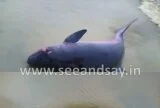Dolphins have social networks too!
- Written by Sharon Shetty
- Comments::DISQUS_COMMENTS
Just like humans, dolphins form highly complex and dynamic networks of friends, preferring to mingle with some fellow dolphins while avoiding others, scientists say.
Researchers studied interactions between bottlenose dolphins in the Indian River Lagoon (IRL), a 251-km long estuary located on Florida’s east coast.
They found that individual dolphins exhibited human-like preference and avoidance behaviour - they have dolphins they like and associate with and ones they avoid.
In the study, scientists at Harbour Branch Oceanographic Institute (HBOI) at Florida Atlantic University learned about the association patterns as well as movement behaviour and habitat preferences of some 200 individual dolphins through intensive photo-ID surveys conducted along the IRL, which were carried out over a six- and-a-half year period.
In a paper published in the journal Marine Mammal Science, researchers said that individual dolphins exhibited both preference and avoidance behaviour.
The study also found that IRL dolphins clustered into groups of associated animals, or ‘communities’, that tended to occupy discrete core areas along the north-south axis of the lagoon system.
“One of the more unique aspects of our study was the discovery that the physical dimensions of the habitat, the long, narrow lagoon system itself, influenced the spatial and temporal dynamics of dolphin association patterns,” said Elizabeth Murdoch Titcomb, research biologist at HBOI.
“For example, communities that occupy the narrowest stretches of the Indian River Lagoon have the most compact social networks, similar to humans who live in small towns and have fewer people with whom to interact,” Titcomb said.
Researchers studied interactions between bottlenose dolphins in the Indian River Lagoon (IRL), a 251-km long estuary located on Florida’s east coast.
They found that individual dolphins exhibited human-like preference and avoidance behaviour - they have dolphins they like and associate with and ones they avoid.
In the study, scientists at Harbour Branch Oceanographic Institute (HBOI) at Florida Atlantic University learned about the association patterns as well as movement behaviour and habitat preferences of some 200 individual dolphins through intensive photo-ID surveys conducted along the IRL, which were carried out over a six- and-a-half year period.
In a paper published in the journal Marine Mammal Science, researchers said that individual dolphins exhibited both preference and avoidance behaviour.
The study also found that IRL dolphins clustered into groups of associated animals, or ‘communities’, that tended to occupy discrete core areas along the north-south axis of the lagoon system.
“One of the more unique aspects of our study was the discovery that the physical dimensions of the habitat, the long, narrow lagoon system itself, influenced the spatial and temporal dynamics of dolphin association patterns,” said Elizabeth Murdoch Titcomb, research biologist at HBOI.
“For example, communities that occupy the narrowest stretches of the Indian River Lagoon have the most compact social networks, similar to humans who live in small towns and have fewer people with whom to interact,” Titcomb said.
Tagged under
- Dolphin
- Social Network
Related items
-
 Injured Dolphin appears in Hosabettu beach: Locals provide first aid
Injured Dolphin appears in Hosabettu beach: Locals provide first aid
-
 People with bigger social networks survive crises more efficiently
People with bigger social networks survive crises more efficiently

